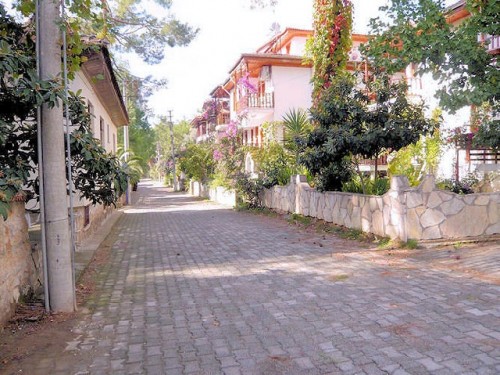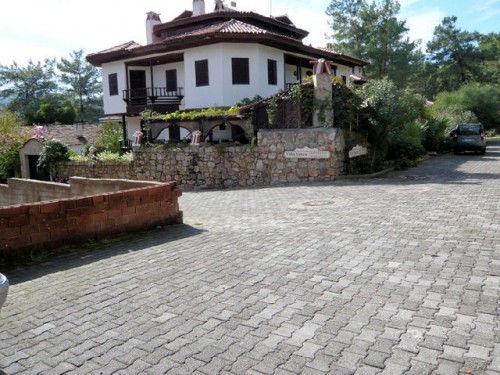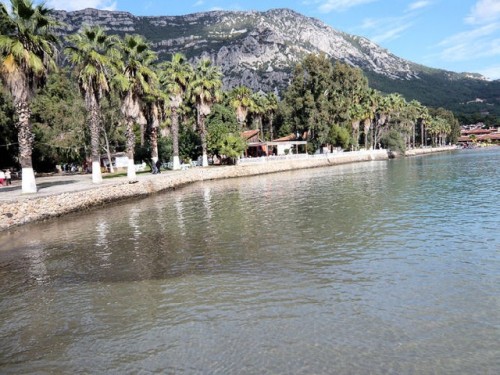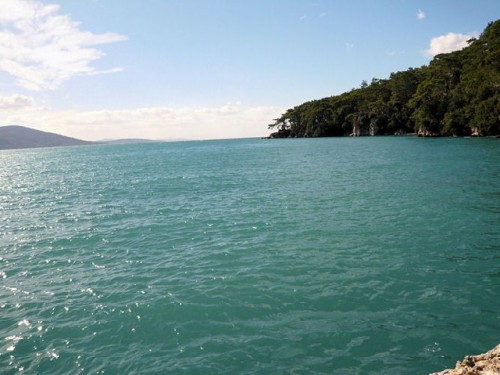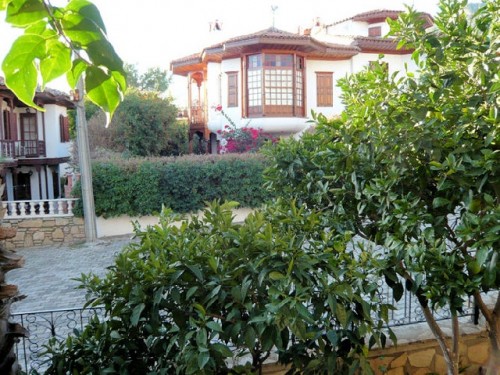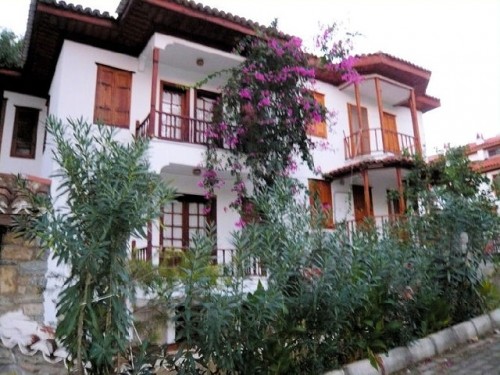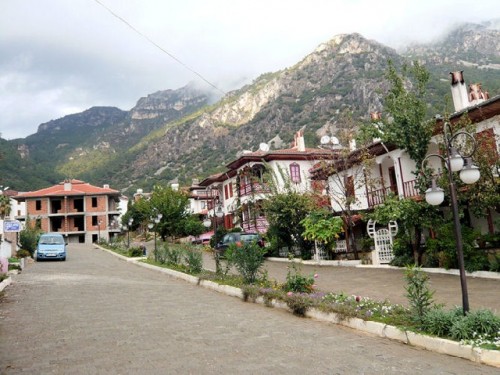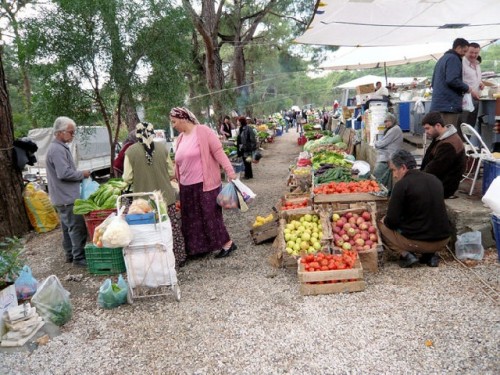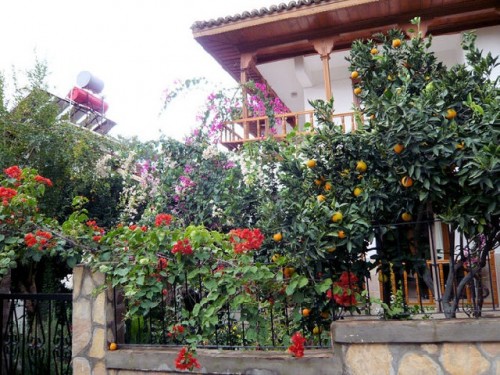Turkey: Akyaka, Gulf of Gokova and Mugla
Mediterranean Towns off the Beaten Path
By: Zeren Earls - Jan 20, 2008
When a high school friend invited me to Akyaka, I welcomed the opportunity to see a region of Turkey new to me. I flew from Istanbul to Dalaman, the closest airport to my destination, forty minutes away by cab. I took the later of available flights off season and arrived in Dalaman around 9 p.m. My friend was at the airport, and since I had no checked luggage for my four-day visit, we headed to Akyaka right away.
My friend's charming country home, which she had designed herself, had two stories with the bedrooms upstairs and the living area and kitchen downstairs. Built from knotty pine, the house was furnished in traditional style, with low seats along the perimeter of the living room, and local printed fabrics or hand-woven textiles as curtains, cushion covers, and bedspreads throughout. My friend lit the gas stove to temper the November chill. We settled in her cozy kitchen to exchange life stories over dinner.
In the morning a neighbor came unannounced to wish my friend a speedy recovery from a minor hand surgery she had undergone, also, delivering bottle of lemon cologne, a basic staple in every Turkish household. As the visitor apologized for not having come sooner, I was reminded of the tradition of impromptu visits among friends and neighbors, often with gifts, which has disappeared in the cities as women have joined the work force.
A walk in the neighborhood revealed a charming, picture-book place with attractive homes and gardens bursting with flowers and orange trees. Everybody seemed to know one another, as my friend stopped to chat and introduced me to others. Local villagers and those, who had relocated here from cities attracted to the climate and natural beauty, seemed to mingle comfortably. We walked to the town center and, through a pine forest, reached the shore, where palm trees lined the turquoise waters of the Mediterranean.
Akyaka sits at the northern shore of Gulf of Gokova along the Mediterranean Sea, within a region historically known as Caria. The first settlements in the region are believed to be from the Early Bronze Age (3500-2000 BC). According to the classical historian Herodotus, the Carians came from the Aegean islands and settled here, mixing with local Anatolians, in1000 BC. Since ancient times, houses have been built to suit the climate and geography of the region, giving it a unique architectural character.
Akyaka's architecture is indeed eye-catching. Introduced to the town by Agha Khan Architecture Award recipient, Nail Cakirhan, the traditional building style of nearby Ula as interpreted by the architect for his own house, has set a local trend. The white houses are made of wood and generally have two stories. They have red tile roofs with brick chimneys, closed flat at the top with triangular openings on the side. Other distinguishing characteristics of these impressive structures are twin doors, opening onto a courtyard, as well as, woodwork patterns adding richness to eaves, gates, shutters, ceilings and cupboard doors. The gardens of houses are large enough to grow vegetables and most feature climbing flowers and citrus trees. Some of these homes offer bed and breakfast and even the hotels reflect the same building style.
The following morning we visited the public library, founded and stocked by a group of residents in the basement of a private home. Students come here after school hours to do homework, read or check-out books. The library is run by volunteers, including a retired school teacher. It was heartening to see this private initiative to inspire youth with a love of reading in a country which scores low in this respect.
Later on we strolled by the small Azmak River, which comes from the mountains and runs through several gardens before flowing into the sea. Ducks play on this babbling stream, which is lined with restaurants. With mountains on one side and the stream on the other, this was a beautiful setting, where we enjoyed grilled fish for lunch. It began to rain, bringing welcome relief after what had been a dry summer. Water tanks on rooftops alongside satellite dishes are a common sight, in this otherwise picturesque town.
Fortuitously, the weekly outdoor market took place during my visit. This market was orderly and calm, and even had a tea garden nearby. I wondered from stall to stall viewing dairy products, produce and grains from nearby villages. Tomatoes, which sell at premium prices in the States, sat in heaps for 50 cents a kilo. I confined my purchases to a block of feta cheese and local olives to take back to Istanbul.
An unexpected delight was a visit to the studio of local artist, Ulku Onur. Unknown beyond this small community, she charmed me with her work in pastels and acrylic paintings. After spending couple of hours over tea in her studio, I purchased a pastel drawing which I could carry back in a poster tube. It is a stylized rendering of a whirling dervish realized in gradations of orange applied in angular planes.
Our one-day excursion to Mugla was most rewarding. We took a minibus along with a few university students who commuted from Akyaka. Mugla, a town with much history, is inland on a high plateau. Seized by the Ottomans in 1390, the old part of the city was a district where Greeks and Turks lived together on friendly terms. Even since the 1924 population exchange, which resulting in the Greeks leaving, the city has retained much of its former charm. Many of the old houses have been restored by their new owners.
As it is my habit to explore local crafts wherever I go, MELSA, a handicraft center, run by a foundation to support the art of hand-made textiles, was our first stop. A quick glance justified Mugla's fame for its woven materials. Then beckoned Arasta, the historical bazaar, which seemed to remain frozen in the early 20th-century with its small saddle- and shoe-makers, barber, hardware and textile shops. We stepped into one of the latter; this time I could not walk out empty-handed.
Following lunch at a small workers' restaurant, we stopped at a carpet shop. Although I have many flat-weave kilims, I fell in love with one featuring stalks of wheat motifs. Woven by villagers, such motifs are often inspired by the weaver's surroundings. After some friendly bargaining, I acquired yet another kilim. Returning to Akyaka, the view was splendid as we passed the Sakar Pass and descended on the winding road towards the gulf below.
In the evening I packed an extra bag for my return trip to Istanbul.

